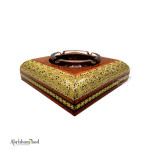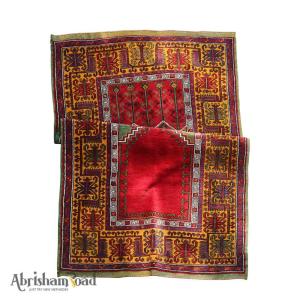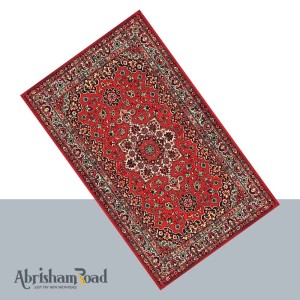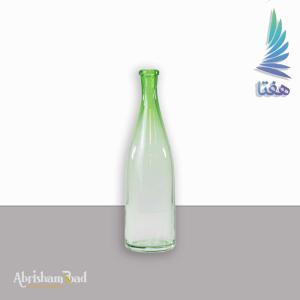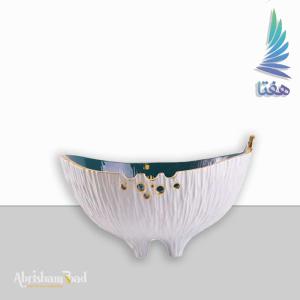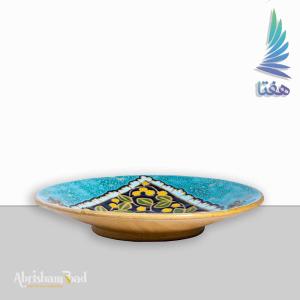Ashtray in Khatam Kari Distributor Only In Iran at special offers
- Discover the exclusive Ashtray Persian Khatam Kari, available solely through distributors in Iran.
- This luxurious piece features intricate design, offered at a corporate price point globally.
- Weighing 320 grams and measuring 12 × 12 × 5 cm, it showcases the skilled craftsmanship of Iranian artisans.
- With a production origin in Iran, this ashtray ensures quality and satisfaction, with an impressive user satisfaction rate of 99%.
Persian Marquetry Khatam Kari Ashtray King Design A Fusion of Art and Utility
The Persian Marquetry Khatam Kari Ashtray is a splendid example of traditional Iranian craftsmanship you can order in Iran, blending artistic elegance with practical utility. Known for its intricate designs and meticulous construction, this ashtray is not just a functional object but also a piece of art that reflects the rich cultural heritage of Iran.
History and Origins Persian Ashtray
Khatam Kari, the art of marquetry, dates back to the Safavid period in Iran, flourishing in the 16th and 17th centuries. This art form involves decorating the surface of wooden or metal objects with delicate pieces of wood, bone, and metal, creating intricate geometric patterns. The word "Khatam" means "incrustation," and Khatam Kari is considered one of the finest examples of Persian decorative arts.
Craftsmanship and Techniques Persian Ashtray
Creating a Khatam Kari ashtray is a labor-intensive process that requires exceptional skill and patience. Artisans begin by selecting high-quality materials, including various types of wood (such as ebony, teak, and walnut), camel bone, and brass or silver. These materials are meticulously cut into tiny pieces, often less than a millimeter thick, and then inlaid into the surface in elaborate geometric patterns.
The process involves several stages Ashtray:
Designing:
The artisan draws a detailed design on paper, planning the layout of the patterns.
Cutting:
The materials are precisely cut into small, thin pieces.
Inlaying:
These pieces are carefully arranged and glued onto the base object.
Sanding and Polishing:
The surface is sanded smooth and polished to enhance the intricate details and ensure a flawless finish.
Design and Patterns Ashtray
Persian Khatam Kari ashtrays are renowned for their elaborate designs, featuring intricate geometric patterns that are symmetrical and harmonious. Common motifs include stars, polygons, and other geometric shapes, often combined in complex arrangements. The use of contrasting colors and materials creates a visually stunning effect, making each ashtray a unique work of art.
Cultural Significance Persian Ashtray
Khatam Kari is more than just a decorative technique; it is a symbol of Persian artistic heritage. Each piece reflects the dedication, skill, and creativity of the artisan, embodying the cultural values of patience, precision, and aesthetic beauty. In Iranian culture, Khatam Kari objects are often treasured as family heirlooms and are used in homes to showcase traditional craftsmanship.
Modern Relevance Ashtray
Today, Persian Marquetry Khatam Kari ashtrays continue to be appreciated for their beauty and craftsmanship. They are popular as decorative items, gifts, and collectibles, admired by art enthusiasts and connoisseurs worldwide. Despite modern technological advancements, the traditional methods of Khatam Kari have been preserved, ensuring that this ancient art form remains alive and vibrant.
Conclusion for Ashtray Persian Khatam Kari Distributor Only in Iran
The Persian Marquetry Khatam Kari Ashtray is a testament to the rich artistic legacy of Iran. Combining functionality with exquisite design, it exemplifies the beauty of Persian craftsmanship. Whether used as an ashtray or displayed as a decorative piece, it stands as a symbol of the intricate artistry and cultural heritage that defines Khatam Kari.
Customer reviews
Add your review
Your email address will not be published. Required fields are marked *
Please login to write review!
1 review(s) for "Ashtray in Khatam Kari Distributor Only In Iran at special offers"

by Abrisham Road
Inspection group .co

Hafta House
- Store rating
4.5
- Staff
40
- Offers
> 100
- Products
8



